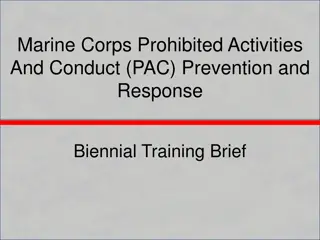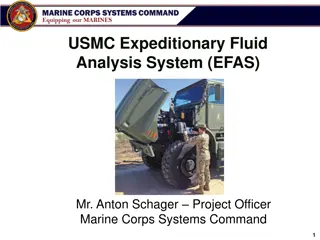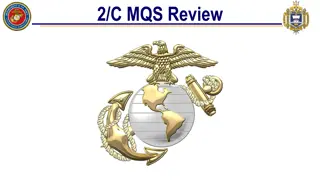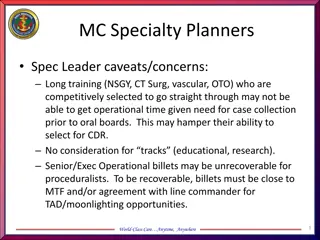Navy/Marine Corps Watch Standing Overview
Understand the essential aspects of Navy/Marine Corps watch standing, including general orders, reasons for standing watch, types of watches, and where watch duties are performed. Learn about the responsibilities involved in watch standing on sea vessels and the importance of maintaining safety and navigation protocols.
Download Presentation

Please find below an Image/Link to download the presentation.
The content on the website is provided AS IS for your information and personal use only. It may not be sold, licensed, or shared on other websites without obtaining consent from the author.If you encounter any issues during the download, it is possible that the publisher has removed the file from their server.
You are allowed to download the files provided on this website for personal or commercial use, subject to the condition that they are used lawfully. All files are the property of their respective owners.
The content on the website is provided AS IS for your information and personal use only. It may not be sold, licensed, or shared on other websites without obtaining consent from the author.
E N D
Presentation Transcript
Learning Topics Introduction General Orders Reasons we stand watch Types of watches Scenario Deck Log Watch terms Watch stations
Definition of a watch Watch: Any period of time during which an individual is assigned specific, detailed responsibilities on a recurring basis
Introduction Watch standing, or watch keeping, in nautical terms concerns the division of qualified personnel to operate a ship continuously around the clock. On a typical sea going vessel, be it naval or merchant, personnel keep watch on the bridge and over the running machinery.
General Orders of the Sentry 1. To take charge of this post and all government property in view. 2. To walk my post in a military manner, keeping always on the alert, and observing everything that takes place within sight or hearing. 3. To report all violations of orders I am instructed to enforce. 4. To repeat all calls from posts more distant from the guard house than my own. 5. To quit my post only when properly relieved. 6. To receive, obey and pass on to the sentry who relieves me, all orders from the Commanding Officer, Command Duty Officer, Officer of the Deck, and Officers and Petty Officers of the Watch only. 7. To talk to no one except in the line of duty. 8. To give the alarm in case of fire or disorder. 9. To call the Officer of the Deck in any case not covered by instructions. 10. To salute all officers and all colors and standards not cased. 11. To be especially watchful at night, and, during the time for challenging, to challenge all persons on or near my post and to allow no one to pass without proper authority.
Reasons We Stand Watch The generic bridge watch standers are lookouts and an officer or mate who is responsible for the safe navigation of the ship. Safe navigation means keeping the vessel on course and away from dangers as well as collision avoidance from other shipping. An engineering specialist ensures that running machinery continues to operate within tolerances depending on the vessel, this can also be accomplished from the bridge. A secondary function of watch keeping is the ability to respond to emergencies, be it on your own ship or involving other ships.
Where We Stand Watch Anywhere and Everywhere The bridge Engineering quarters Security checkpoints Communication
Types of Watches Engineering watches Engineering Officer of the Watch Damage Control Watch Officer Boiler watches Electrical, intercom, and auxiliary watches Main engine and auxiliary watches Roving watches Naval (Bridge) Officer of the Deck Junior Officer of the Deck Junior Officer of the Watch Conning Officer Quartermaster of the Watch Boatswain's Mate of the Watch Helmsman/Lee Helmsman Lookout Low-visibility detail
More Watches Naval Petty Officer of the Watch Officer of the Deck (In-port) Roving patrol Sounding and security Pier sentry Radio watches Message center Signal bridge watches Anchor watch In-port Boat Officer Department Duty Officer Communications Watch Officer Tactical Action Officer Command Duty Officer Combat Information Center Watches Combat Information Center Watch Officer Other CIC Watches
Deck Log A Navy ship's deck log is a daily chronology of certain events for administrative and legal purposes This specifies the kinds of events to be entered: Absentees Accidents [material] Accidents/Injuries [personnel] Actions [combat] Appearances of Sea/Atmosphere/Unusual Objects Arrests/Suspensions Arrival/Departure of Commanding Officer Bearings [navigational] Cable/Anchor Chain Strain Collisions/Groundings Many more
What information is not in deck log? Shipyard work Individual work assignments Events occurring elsewhere Deaths Injuries Medical records **Deck Logs are not Captain Logs
Watch, Quarter, and Station Bill It shows the personnel duty assignments for a division as specified in the ship's battle organization and regulation's manual. Its purpose is to inform division personnel of their assignment The ship s organized plan for action is contained in the battle bill. Based on the organization manual and other publications and directives. Contains lists of stations that must be manned during battle and at other specified times. Using the organization manual and the battle bill as references, each division officer and division chief assigns qualified personnel in the division to the stations and enters their names on the watch, quarter, and station bill
Conclusion Know the general orders of the sentry Never leave a post unless properly relieved Get used to standing watch now You signed up for a career in the navy and you will be standing watch as long as you're still a member.
Resources OPNAVINST 3100.7B Watch Standing (BMR)

 undefined
undefined






























